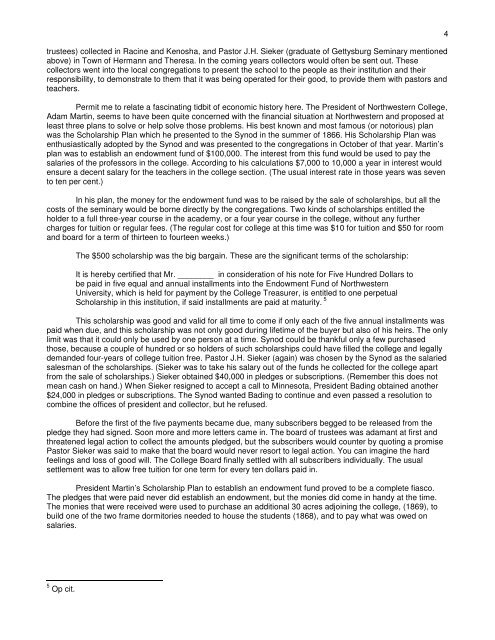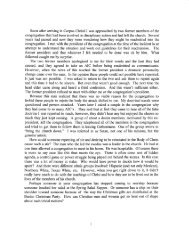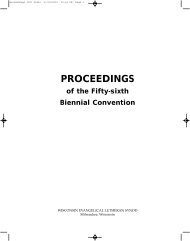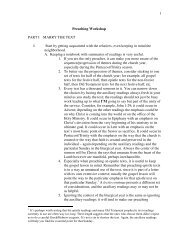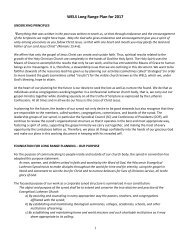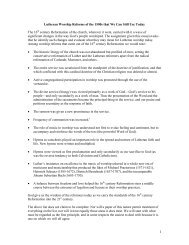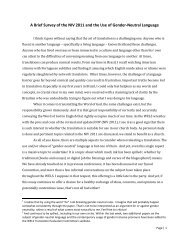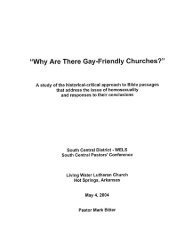A History of the WELS - The South Central District
A History of the WELS - The South Central District
A History of the WELS - The South Central District
Create successful ePaper yourself
Turn your PDF publications into a flip-book with our unique Google optimized e-Paper software.
trustees) collected in Racine and Kenosha, and Pastor J.H. Sieker (graduate <strong>of</strong> Gettysburg Seminary mentioned<br />
above) in Town <strong>of</strong> Hermann and <strong>The</strong>resa. In <strong>the</strong> coming years collectors would <strong>of</strong>ten be sent out. <strong>The</strong>se<br />
collectors went into <strong>the</strong> local congregations to present <strong>the</strong> school to <strong>the</strong> people as <strong>the</strong>ir institution and <strong>the</strong>ir<br />
responsibility, to demonstrate to <strong>the</strong>m that it was being operated for <strong>the</strong>ir good, to provide <strong>the</strong>m with pastors and<br />
teachers.<br />
Permit me to relate a fascinating tidbit <strong>of</strong> economic history here. <strong>The</strong> President <strong>of</strong> Northwestern College,<br />
Adam Martin, seems to have been quite concerned with <strong>the</strong> financial situation at Northwestern and proposed at<br />
least three plans to solve or help solve those problems. His best known and most famous (or notorious) plan<br />
was <strong>the</strong> Scholarship Plan which he presented to <strong>the</strong> Synod in <strong>the</strong> summer <strong>of</strong> 1866. His Scholarship Plan was<br />
enthusiastically adopted by <strong>the</strong> Synod and was presented to <strong>the</strong> congregations in October <strong>of</strong> that year. Martin’s<br />
plan was to establish an endowment fund <strong>of</strong> $100,000. <strong>The</strong> interest from this fund would be used to pay <strong>the</strong><br />
salaries <strong>of</strong> <strong>the</strong> pr<strong>of</strong>essors in <strong>the</strong> college. According to his calculations $7,000 to 10,000 a year in interest would<br />
ensure a decent salary for <strong>the</strong> teachers in <strong>the</strong> college section. (<strong>The</strong> usual interest rate in those years was seven<br />
to ten per cent.)<br />
In his plan, <strong>the</strong> money for <strong>the</strong> endowment fund was to be raised by <strong>the</strong> sale <strong>of</strong> scholarships, but all <strong>the</strong><br />
costs <strong>of</strong> <strong>the</strong> seminary would be borne directly by <strong>the</strong> congregations. Two kinds <strong>of</strong> scholarships entitled <strong>the</strong><br />
holder to a full three-year course in <strong>the</strong> academy, or a four year course in <strong>the</strong> college, without any fur<strong>the</strong>r<br />
charges for tuition or regular fees. (<strong>The</strong> regular cost for college at this time was $10 for tuition and $50 for room<br />
and board for a term <strong>of</strong> thirteen to fourteen weeks.)<br />
<strong>The</strong> $500 scholarship was <strong>the</strong> big bargain. <strong>The</strong>se are <strong>the</strong> significant terms <strong>of</strong> <strong>the</strong> scholarship:<br />
It is hereby certified that Mr. ________ in consideration <strong>of</strong> his note for Five Hundred Dollars to<br />
be paid in five equal and annual installments into <strong>the</strong> Endowment Fund <strong>of</strong> Northwestern<br />
University, which is held for payment by <strong>the</strong> College Treasurer, is entitled to one perpetual<br />
Scholarship in this institution, if said installments are paid at maturity. 5<br />
This scholarship was good and valid for all time to come if only each <strong>of</strong> <strong>the</strong> five annual installments was<br />
paid when due, and this scholarship was not only good during lifetime <strong>of</strong> <strong>the</strong> buyer but also <strong>of</strong> his heirs. <strong>The</strong> only<br />
limit was that it could only be used by one person at a time. Synod could be thankful only a few purchased<br />
those, because a couple <strong>of</strong> hundred or so holders <strong>of</strong> such scholarships could have filled <strong>the</strong> college and legally<br />
demanded four-years <strong>of</strong> college tuition free. Pastor J.H. Sieker (again) was chosen by <strong>the</strong> Synod as <strong>the</strong> salaried<br />
salesman <strong>of</strong> <strong>the</strong> scholarships. (Sieker was to take his salary out <strong>of</strong> <strong>the</strong> funds he collected for <strong>the</strong> college apart<br />
from <strong>the</strong> sale <strong>of</strong> scholarships.) Sieker obtained $40,000 in pledges or subscriptions. (Remember this does not<br />
mean cash on hand.) When Sieker resigned to accept a call to Minnesota, President Bading obtained ano<strong>the</strong>r<br />
$24,000 in pledges or subscriptions. <strong>The</strong> Synod wanted Bading to continue and even passed a resolution to<br />
combine <strong>the</strong> <strong>of</strong>fices <strong>of</strong> president and collector, but he refused.<br />
Before <strong>the</strong> first <strong>of</strong> <strong>the</strong> five payments became due, many subscribers begged to be released from <strong>the</strong><br />
pledge <strong>the</strong>y had signed. Soon more and more letters came in. <strong>The</strong> board <strong>of</strong> trustees was adamant at first and<br />
threatened legal action to collect <strong>the</strong> amounts pledged, but <strong>the</strong> subscribers would counter by quoting a promise<br />
Pastor Sieker was said to make that <strong>the</strong> board would never resort to legal action. You can imagine <strong>the</strong> hard<br />
feelings and loss <strong>of</strong> good will. <strong>The</strong> College Board finally settled with all subscribers individually. <strong>The</strong> usual<br />
settlement was to allow free tuition for one term for every ten dollars paid in.<br />
President Martin’s Scholarship Plan to establish an endowment fund proved to be a complete fiasco.<br />
<strong>The</strong> pledges that were paid never did establish an endowment, but <strong>the</strong> monies did come in handy at <strong>the</strong> time.<br />
<strong>The</strong> monies that were received were used to purchase an additional 30 acres adjoining <strong>the</strong> college, (1869), to<br />
build one <strong>of</strong> <strong>the</strong> two frame dormitories needed to house <strong>the</strong> students (1868), and to pay what was owed on<br />
salaries.<br />
4<br />
5 Op cit.


